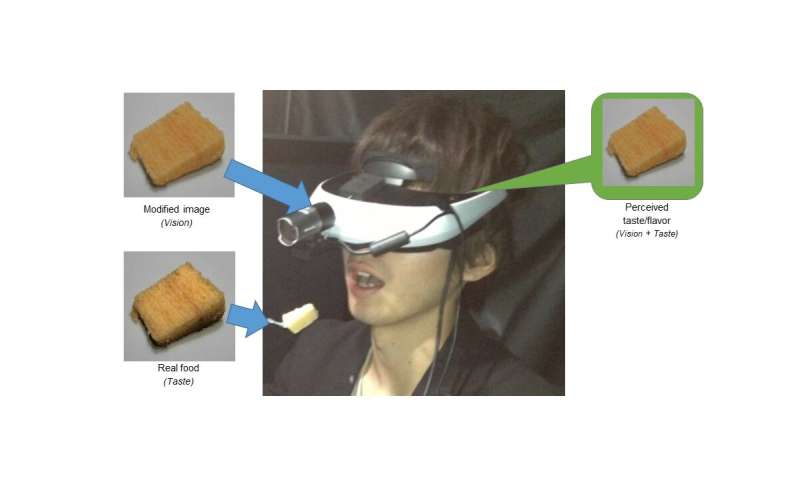
Researchers have developed an augmented reality (AR) visor system that enables them to manipulate the light coming off food in such a way as to ‘trick’ people consuming the food into experiencing it as more or less moist, watery, or even delicious. The findings not only reveal how human taste is experienced in a multisensorial way—through a combination of visual perception, smell and even sound—but the technique could be used in hospitals to improve the palatability of food, or as a design development tool in the food industry.
The findings were published in Scientific Reports on September 30, 2020.
It has long been known that taste is not only a product of a food’s chemical composition, which directly shapes the experience of consumption of food and drink, but that its visual appearance also contributes to how we experience its taste.
For example, research has shown that humans tend to associate sour-tasting food and carbonated beverages with sharper shapes, and to associate creamy food and still drinks with more rounded shapes. Underlying that visual experience is the way that light bounces off an object, or—to put it in more scientific terms—the distribution of luminance. Earlier research had shown that variation in this luminance distribution influences how fresh a cabbage appears to people when looking at a series of still pictures of the vegetable. But pictures are not the same as the dynamic experience of actually eating a piece of food.
“So we wondered whether manipulating this luminance distribution while someone was eating something would produce a similar effect,” said Katsunori Okajima, who specializes in vision and brain sciences at Yokohama National University in Japan.
The researchers developed an augmented reality (AR) system that allows them to manipulate the standard deviation of luminance distribution. This is a statistical term that describes how spread out a set of numbers are from their average value. So for example, the total amount of light bouncing off two different slices of cake might be the same, but for the first slice, the deviation of luminance distribution is small, giving it a smoother appearance, while the deviation is large for the second slice, giving it a rougher appearance.
They used their AR system in two experiments. In the first, people wore the AR visor system while eating slices of Baumkuchen, a type of German cake widely available in Japan, and in the second they wore it while eating a spoonful of ketchup. The researchers were thus able to manipulate the appearance during consumption of food, going one step further than the photographs of cabbage.
Upon interviewing the participants, they found that manipulating the standard deviation of the luminance distribution (while keeping the color and the overall luminance constant) altered not only what the participants expected to taste in terms of moistness, wateriness and deliciousness, but also the actual taste and texture properties upon sampling the food itself.
The AR manipulation was most effective in moistness (of the cake) and wateriness (of the ketchup), while the effect of the system on perception of sweetness was relatively modest
“This suggests that the association between visual texture and sweetness is weak,” added Dr. Okajima.
Source: Read Full Article